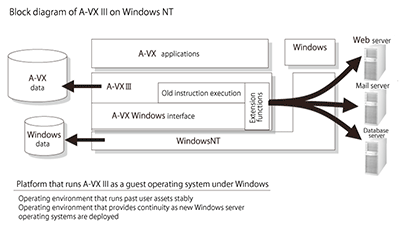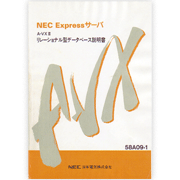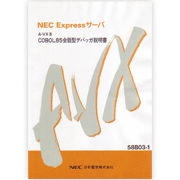As open-platform operating systems (UNIX and Windows) grew in popularity, A-VX III included functionality so it could work in conjunction with these open-platform operating systems to implement various systems that could not be implemented strictly with an office computer operating system alone. A-VX III also made it possible to continue using user assets from office servers (System 7200 series) and to work in conjunction with Windows NT application software.
A-VX III, essentially, was an upgrade that allowed the previous A-VX II office server operating system to run on Windows NT. A data conversion utility (#NFCNV) was provided that bidirectionally converted A-VX files and Windows NT files (csv and txt files). A-VX III also came with a function so that A-VX COBOL programs and utilities could directly read and write files (csv and txt files) on Windows NT.
Executable programs created on the first office computer operating system, ITOS, could still be used even as late as the S7200 office server because CPU compatibility was maintained. However, the new Express 5800/700 series used a high-speed RISC processor that was not backward compatible with older CPUs and, therefore, could not run past executable programs as is. As a result, NEC implemented in software a structure that interpreted the previous CPU instructions of old programs so they could be executed on the new CPU. With this structure, then, old executable programs could be run without modification. This technology would be used again on the next A-VX IV operating system and would preserve the usability and continuity of legacy executable programs.

- Home >
- Historical Computers in Japan >
- Office Computer OS >
- A-VX III
【NEC】 A-VX III

The provision of LAN Manager server functions in the A-VX operating system generation and the development of systems that worked with UNIX proved to be useful on the technical front for the development of A-VX III.
 |  | |
| Cover of the NEC A-VX III relational database manual | Cover of the NEC A-VX III COBOL 85 interactive debugger manual |
All Rights Reserved, Copyright (C) Information Processing Society of Japan
